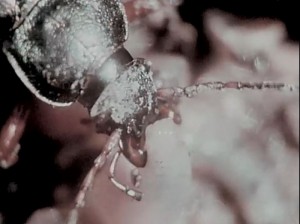
"To film an insect well, when it is crawling, creeping or flying, is a real feat. Francis M. Spoonogle does this with great success. In his film, Backyard Zoo, he has taken completely undirectable creatures and has managed to capture them on film with such intimacy as to give one the feeling that he might be living for a while in the insect world. Unsuspected beauty is revealed in the coloring of caterpillars with normally unseen fur collars. So sharply has he focused on insect life in this beautiful 8mm. film that the "feathers," making up the coating of a butterfly's wings, are almost discernible." Movie Makers, Dec. 1945, 495-496.

"The very great faculty of Robert P. Kehoe for seeing natural beauty and giving it an individual and entirely original expression in film enables him, in Brookside, to reach a new height in cinematography, because he has added to that faculty an attention to the business of continuity. Like Tennyson's Brook, Mr. Kehoe"s film starts to go somewhere, keeps going and gets there, while we who watch the going see, by the brookside, some of the loveliest — but tripodless — footage of water, flowers and woodland that any landscapist could want to come by. The final sequence of Mr. Kehoe's picture has a tragic tenderness that is almost too poignant, since he has filmed the funeral progress down the darting brook of a lustrous butterfly that ventured too close to the water and was sucked into it. With wings outspread, the little body goes past us into '"yesterday's ten thousand years" as the film ends." Movie Makers, Dec. 1941, 565.

"The late and unlamented war kept amateur movie makers — along with the rest of peripatetic America — pretty close to their backyards. Robert S. Walker is one who has made this restriction pay dividends. The result is Butterflies, a charming study of these winged wanderers of blossomland. Those filmers who have ventured into the field of extreme closeup work will understand and applaud the patient skill with which Mr. Walker got wellnigh perfect results in recording each new specimen. Rhymed quatrains serve, with the scenes, to create a film of light and airy entertainment." Movie Makers, Dec. 1945, 496.

"The Butterfly with Four Birthdays is a well done documentary on the life cycle of the Anise Swallowtail (Papilio Zelicaon). The Zelicaon, often mistaken for the Monarch, lives in the Western United States and lays her eggs on the anise plant, also known as sweet fennel. From the egg comes the baby caterpillar, thirdly the pupa or chrysalis stage, and finally, on its fourth birthday, the butterfly. This film also received the MPD Nature Film Award" PSA Journal, Sept. 1965, 50.

"Butterflies are John Larson's subject in this carefully planned and filmed record of the life cycle of the lepidoptera which are the Frail Children of the Sun. We are shown the beauty of the highly colored flower visitors and their varied and geometrically startling decorativeness, in footage of comforable length which fixes our interest on the movie's main topic. This is then elaborated in sequences that are not only excellently recorded in Kodachrome, but that give real information about the brief but eventful existence of the butterfly through its various incarnations. The film ends with more footage of the beauty of the summer and of the butterflies that add to that beauty." Movie Makers, Dec. 1943, 477-478.

"Some of the most beautiful insects of France. Coleoptera (beetles, beetles, longhorn beetles, etc.). Lepidoptera: eggs, caterpillars, pupae, accelerated birth (zygène), slow flights (papilio, zygène, sphinx, etc.). Parasitic and predatory insects: braconid, pentatomide, ammophile, mantis." rough english translation of a description provided by Canal-U.
"Monarch Butterfly Story: This film, with its carefully written and recorded narration, is equally meticulous in its photography which chronicles the life-cycle of the Monarch butterfly from egg to adult. Major Anderson and his wife Claire Louise have collaborated in producing one of the finest studies of insect life ever produced by a non-professional film maker, and already one large educational film distributor is negotiating for its purchase. Employing two Bolex H-16 cameras, the Andersons have produced several excellent sequences in time-lapse photography aided by equipment home-made for the purpose by Mr. Anderson. The picture opens with scenes showing adult Monarchs in natual habitat. Interesting facts regarding the butterfly are told in the narration. Then the egg-laying period is shown, followed by closeups of the egg, hatching of the pupa, and it ultimate growth to an adult through the various stages of metamorphosis natural to the Monarch. It is the meticulous ultra-closeup photography and the perfectly executed time-lapse camera work that gives this production its class, and easily makes it one of the best 16mm color films of the year." American Cinematographer, May. 1951, 190.
"The Monarch Butterfly, winner of the MPD Nature Film Trophy, depicts the life cycle of this well known butterfly and shows the various stages through which it must pass" PSA Journal, Sept. 1966, 35.
Total Pages: 2